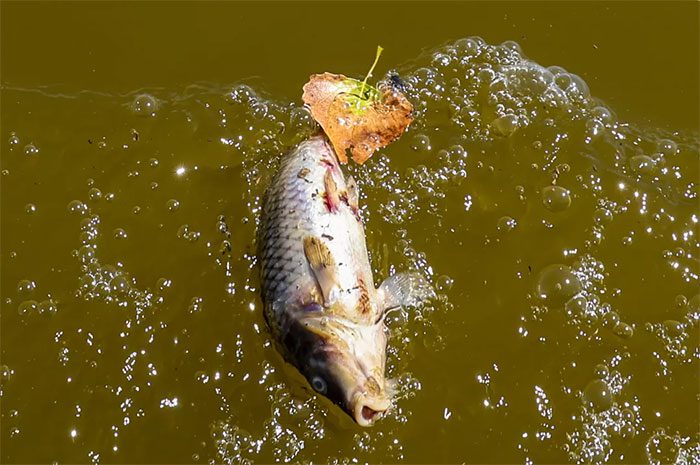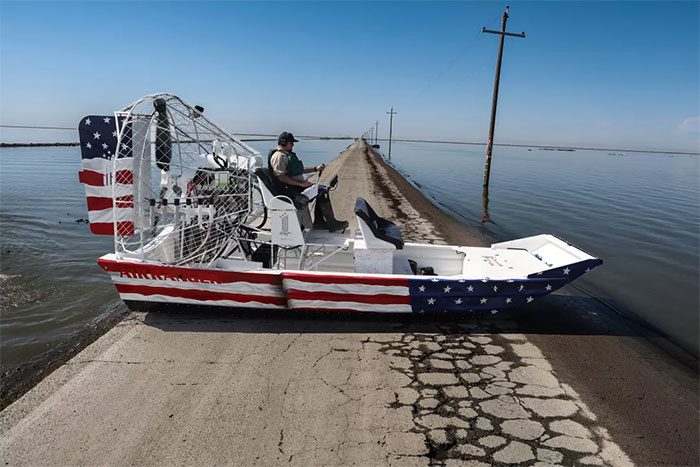“Ghost Lake” Tulare resurfaces in California, USA, submerging thousands of acres of agricultural land in the region.
“Ghost Lake” Returns
The scorching sunlight reflects off the calm surface of the lake. Small dead fish float beside the water pipes. Less than 2 meters below the water’s surface, abandoned chicken coops, dairy barns, and deteriorating warehouses gradually fade from view, barely visible through the murky green water.
The summer heat of the Central Valley does not relent, even while paddling through this “ghost lake.” “Ghost Lake” Tulare was reborn last spring after intense winter storms and snowmelt from the Sierra Nevada overwhelmed the long-depleted systems that had drained the Tulare Lake Basin.
The revived Tulare Lake has submersed thousands of acres of farmland used for growing cantaloupe, almonds, cotton, and sugarcane in one of the most productive agricultural regions in the United States.
Despite this, with the return of Tulare Lake, ducks, herons, and other birds have flocked to the site. As Tulare Lake reclaims its land, long-forgotten ecosystems are being revitalized.
The Los Angeles (LA) Times took a tour with the Kings County Sheriff’s Office to patrol the newly reformed lake.

The surface of “Ghost Lake” Tulare. (Photo: LA Times).
Agricultural Land Submerged
“When the lake emerged, it showed us a completely overwhelming image,” Sheriff Nate Ferrier said while standing on the lakeshore. Even months after the appearance of “Ghost Lake” Tulare, he remains astonished by its scale and presence.
“I drove up and down all these roads just to witness the water covering the entire agricultural area. It feels like a moment out of the Bible.”
The sheriff’s office reported that they had to invest in a motorboat to collect debris on the lake’s surface and ensure that the boat’s propellers did not get stuck on submerged items.
The lake inundates agricultural land and private property. Therefore, wading or boating on the lake is considered trespassing. The lakeshore is marked with numerous signs stating “Private Property,” warning against hunting, fishing, or trespassing on the land.
<pHowever, at this moment, what lies beneath the surface is of greater concern. Floodwaters have “devoured” fertilizer storage and other chemicals. Along with crop feed, the water has swallowed electricity lines and sharp agricultural machinery.
Officer Ferrier noted that so far, they have not had to deal with situations where residents protested against boats moving on the water. This has also posed a disadvantage, as the floodwaters do not deter people from approaching. In August, police encountered a silver Nissan car abandoned underwater, half-submerged. The vehicle had not been seen at this location before.
In other instances, officers also discovered people fishing in the area. Police issued a warning that the fish in the lake might not be safe for consumption.
“Many people have said that the lake water is quite dirty. Therefore, the fish here are unsafe. I advise everyone not to eat the fish due to the lake’s pollution, and we don’t even truly know all that lies beneath the surface. So, it’s not worth the risk,” the police stated.
“However, people need to learn to coexist with the water,” Ferrier said.

The police patrol boat. (Photo: LA Times).
The Mystery Beneath the Lake
The farms submerged by the lake were once home to farmers. Carports can still be seen in some areas of shallow water. Roads that had been “devoured” are gradually reemerging, with cracking asphalt. Power poles protrude above the water.
Near the chicken farm, a foul smell permeates the air. Signs declaring the agricultural land as a “biosafety zone” still stand upright.
LA Times reported that gliding over the lake’s surface in a motorboat, new signs of life mingle with signs of another life that has been submerged by floodwaters. Herons nest among the highest branches of flooded trees. Wild ducks swim by, diving down into the water for food. Yellow butterflies flutter above the water.
Rose Mary Rahn, Director of the Kings County Public Health Department, stated that exactly what is in the water, including pesticides, chemicals, and bacteria, remains a mystery. Kings County has conducted surface water testing, and the latest results in July identified high levels of coliform bacteria and E. coli.
The last time the lake returned was in 1983, at which time, the “ghost lake” persisted for 2 years before disappearing. Local officials also noted that it would take many years before the water in the “ghost lake” fully recedes.


















































